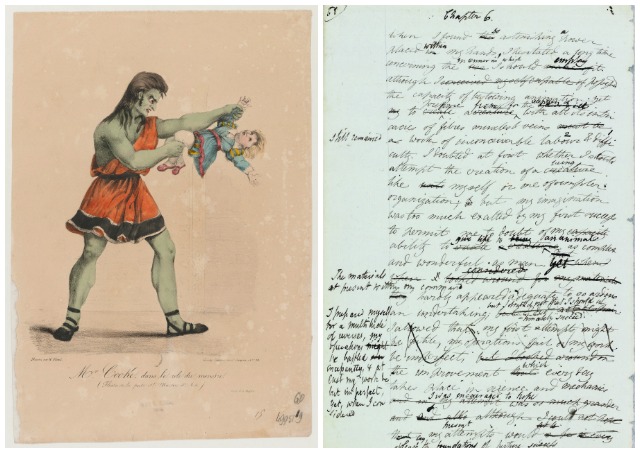THE weather on Lake Geneva in June 1816 was especially bad — we know what that’s like lately but rather than climate change being the culprit as it is today, a volcanic eruption in faraway Indonesia was to blame for the storms over Europe that Summer. (Well, in fact, the eruption did evoke catastrophic climate change for years after its eruption leading to widespread crop failure and mass hunger on the continent.)
Torrential rain was proving tedious for five young visitors to the area — all exiles from scandal and debt in London — and one of them, their host one sodden evening at his rented digs, the Villa Diodati in Cologny, put down a challenge as a means of distraction: “We will each write a ghost story,” he said.
Frankenstein: the first science fiction novel

The works resulting from that competition would achieve literary acclaim and over time, none more so than that of 19-year-old Mary Godwin, the lover and soon-to-be wife of the renowned poet Percy Bysshe Shelley who was there along with their host, the infamous Lord Byron and the latter’s personal physician John William Polidori.
It took some time for Mary to come up with an idea, but in the early hours of the 16th June one began to take frightening shape and she put pen to paper. Two hundred years after its ‘birth’ at the Villa Diodati, the original manuscript of Mary’s “Frankenstein” has returned to Cologny where it is being displayed at the Fondation Martin Bodmer as part of a small but impressive exhibition entitled Frankenstein: Creation of Darkness until 9th October 2016.
Frankenstein reflects the concerns of its age

The novel, published anonymously in 1818, became an immediate bestseller. It explored themes that then, and still today, challenge and concern society: unlimited scientific progress, morality and personal responsibility, the unsettling marriage of technology and biology, as well as issues of loneliness, loss and isolation.
The story and its themes were further explored in subsequent essays, theatrical adaptations and artwork of the time, and in the 20th century on film and most recently on television (for e.g. Penny Dreadful ).
Well read and surrounded by philosophical discussion

The exhibition is a collaboration between the Martin Bodmer Foundation and the Bodleian Library in Oxford, and gathers some 100 objects. These include the original manuscript of the novel as well as the first edition with Mary’s annotations; her personal diary, which includes references to her work on the novel; her portrait and those of the other guests at Cologny.
Also on display are the first editions of scholarly, philosophical works that Shelley had read and which influenced her thinking during the writing of Frankenstein, including Paradise Lost by John Milton, Goethe’s The Sorrows of Young Werther, and The Confessions of Jean-Jacques Rousseau.
“Man,” I cried, “how ignorant art thou in thy pride of wisdom.” Frankenstein.
Though only 19 when she began the novel, Mary had been encouraged in her informal education through books by her father, the political philosopher William Godwin, (her mother, Mary Wollstonecraft, an early advocate of women’s rights, died shortly after Mary’s birth) and she was doubtless influenced by the philosophical, liberal-minded discussions in her circle of family and friends.
Also, by the time Frankenstein appeared she had also known personal loss, having already experienced the death of one child (she would lose two more; her last, Percy, survived her after her death from a brain tumor at the age of 53), which must have played itself out in the book’s themes of loss, love and family.
It took years before Mary Shelley achieved the credit and acclaim she deserved for writing a book that quite literally and in so many ways continues to haunt us to this day.
Full agenda of activities through October

The Martin Bodmer Foundation has organized a full line-up of events celebrating the novel’s publication and exploring the various issues that it raises.
You can view highlights of these events on the Martin Bodmer Foundation agenda page, and more fully on the dedicated website Frankenstein aujourd’hui (check events by month and be sure to click on “Et encore” for events scheduled at partner outlets, including films at the Cinema Grütli, an exhibition at the Musée Rath, and a guided tour on 21 August entitled “The Geneva of Victor Frankenstein”). Many of these events require prior registration.
“How mutable are our feelings, and how strange is that clinging love we have of life even in the excess of misery!” Frankenstein.
Of particular note are the special events (in French) at the Bodmer Foundation in Cologny that are scheduled for the evening of 16 June from 17h00-23h00.
Happy Birthday Frankenstein! includes a guided tour for young people at 17h00, a pic nic on the grounds (via food truck), a writing contest, theatrical “moments” and a guided tour for adults at 21h00. Be sure to sign up by going to June 16 on the agenda page and clicking on the headline.
The majority of events are conducted in French however two guided tours in English are scheduled at the Foundation on Saturday, 18 June at 14:15 and on Sunday, 26 June at 14:15, which are included in the price of admission. No need to register in advance, just be there on the day.
You can find all you need to know, including opening hours, entrance fee, public transportation, and contact information on the page Martin Bodmer Foundation Practical Information.
Main photo caption: The Martin Bodmer Foundation in Cologny houses some 150,000 documents dating from the origins of writing to the present day and includes a museum designed by Swiss architect Mario Botta where the Frankenstein exhibit is displayed.


10 responses to “Mary Shelley’s “Frankenstein” returns to Cologny 200 years after its birth”
Looks outstanding. Wish I could.
LikeLike
I know what you mean. It’s hard when we want to visit an exhibition but can’t for whatever reason!
LikeLiked by 1 person
This is SO interesting. Amazing that she was so young when she wrote this work. I wish I could see this exhibition and take my time exploring all aspect of it.
LikeLike
Wish I could do that with you…
LikeLike
What a great story and so well researched
LikeLike
Many thanks, Monsieur!
LikeLike
I really wish I could see this exhibition and attend some if not all of these events. It’d be wonderful to see the exhibition surrounded by where it was set, too!
Your post was beautifully written and laid out, Elena. It’s truly impressive how interesting and crafted your posts and site is!
xoxox
Pam
LikeLike
I agree, being in the same area where it was written gives the exhibition special resonance. So glad you enjoy the post and the blog, Miss Grimaud, helps to make it worthwhile doing 🙂
LikeLike
Fascinating post, Elena! And, of course, very well-written. It looks like a great exhibition.
LikeLike
Thanks, Heddi, it’s a thrill to be so close to the original work. Also, the entire first-edition book collection at the Foundation is stunning.
LikeLiked by 1 person